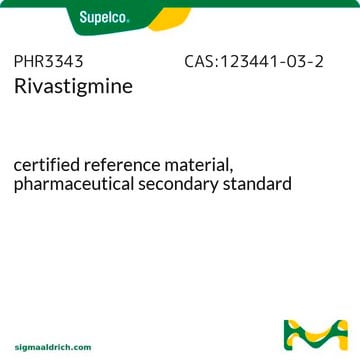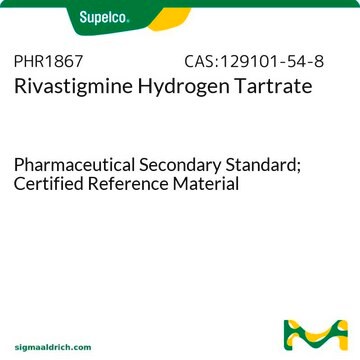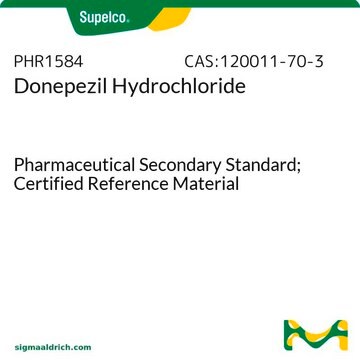SML0881
Rivastigmine tartrate
≥98% (HPLC)
Synonym(s):
ENA-713, Ethylmethyl-carbamic acid 3-[(1S)-1-(dimethylamino)ethyl]phenyl ester, N-Ethyl-N-methyl-carbamic acid 3-[(1S)-1-(dimethylamino)ethyl]phenyl ester tartrate, S-Rivastigmine tartrate
About This Item
Recommended Products
Assay
≥98% (HPLC)
form
powder
storage condition
desiccated
color
white to beige
solubility
H2O: 15 mg/mL, clear
storage temp.
2-8°C
InChI
1S/C14H22N2O2.C4H6O6/c1-6-16(5)14(17)18-13-9-7-8-12(10-13)11(2)15(3)4;5-1(3(7)8)2(6)4(9)10/h7-11H,6H2,1-5H3;1-2,5-6H,(H,7,8)(H,9,10)/t11-;1-,2-/m00/s1
InChI key
GWHQHAUAXRMMOT-RWALOXMOSA-N
Looking for similar products? Visit Product Comparison Guide
General description
Application
Biochem/physiol Actions
Features and Benefits
Signal Word
Danger
Hazard Statements
Precautionary Statements
Hazard Classifications
Acute Tox. 2 Oral - Aquatic Chronic 2
Storage Class Code
6.1A - Combustible acute toxic Cat. 1 and 2 / very toxic hazardous materials
WGK
WGK 3
Flash Point(F)
Not applicable
Flash Point(C)
Not applicable
Certificates of Analysis (COA)
Search for Certificates of Analysis (COA) by entering the products Lot/Batch Number. Lot and Batch Numbers can be found on a product’s label following the words ‘Lot’ or ‘Batch’.
Already Own This Product?
Find documentation for the products that you have recently purchased in the Document Library.
Customers Also Viewed
Articles
Acetylcholine is synthesized from acetyl coenzyme A and choline by the enzyme choline acetyltransferase. In addition to its synthesis in the liver, choline employed in acetylcholine production is derived from dietary sources.
DISCOVER Bioactive Small Molecules for Neuroscience
Our team of scientists has experience in all areas of research including Life Science, Material Science, Chemical Synthesis, Chromatography, Analytical and many others.
Contact Technical Service













